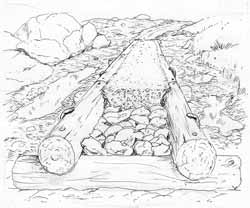bog bridges and turnpike: the deil's ay in the details
A few technical points for this discussion: first, relocate the trail to dryer better-drained ground if at all feasible. If not feasible, then
- second, largish stepstones set in cone-shaped holes are more permanent and need less building and upkeep than turnpike, which allows the walker to not watch their feet, unlike the rest of our trails. Turnpike is miniature road, and not usual on New England hiking trails. But there are places where the user group is in street shoes, and turnpike is easy for them. Such places tend to be near roads for importing materials, and on the lands of owners willing to buy them. If turnpike is chosen, then
- The sketch of "trail building turnpike" is quite helpful in showing the proper construction to achieve the goal of a dry all-weather treadway across wet ground. It is important to leave the top of the sills an inch or so above the ground surface so as to leave that inch of space between ground and the bottom of what I'll call the retaining logs. That inch lets water drain freely through the small rocks that fill the turnpike up to halfway up the retaining logs. Pack them so as to not let any more gravel than necessary fall down between them. Crown the gravel at the center of the treadway, and plan on re-crowning every year or so, as well as adding more gravel so it sheds rain to each side.
The problem here is that for this to work to specs you need a large supply of small rocks and another of gravel. Sometimes you find a gravel bank and the small rocks can be raked out of it as you excavate. The difficulty of finding enough of these materials means you often make the turnpike as low as possible and still work, but I would prefer to have at least 6" of small rocks and 2" of gravel not counting the crown. I have seen some attempts at turnpike where larger rocks were thrown in at random and black soggy organic soil piled around them. The side retainers hold water in, the soil compacts, and what you have is slippery rocks to walk on.
If I was not assured of a good supply of gravel (rocks are seldom lacking),
then bog bridges are faster and easier than turnpike. Same type and amount of wood, no minerals to find, sift, move, tamp, and fix. Flattening the tops of stringers is far less work. To be stable in our climate and under live loads, the sills should be at least four feet wide. My crews leave no more than 2" between the stringers, about two fingers wide, but it is important to leave that space because we need to have good drainage and let twigs, leaves etc. fall through so they do not stay between the logs, hold moisture, and accelerate rot. Part of the adopter's job is to keep that gap open every time they go there. A shod foot will not go through a 2" gap. We also flatten the bottom of the stringer where it sits atop the sill, with one spike through a predrilled pilot hole to keep it in place. This allows good drainage at the joint, which further lengthens its life.
To prioritize our choices on hiking trails: 1) relocate to dry ground; 2) stepstones; 3) bog bridges; 4) turnpike.
Creag nan drochaid


